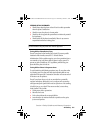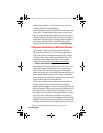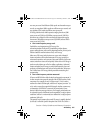Section 4: Safety Guidelines and Warranty Information
108 4A: Safety
measure of the rate of absorption of RF energy. It is usually expressed in
units of watts per kilogram (W/kg) or milliwatts per gram (mW/g).
4. What biological effects can be caused by RF energy?
The biological effects of radio frequency energy should not be confused
with the effects from other types of electromagnetic energy.
Very high levels of electromagnetic energy, such as is found in X-rays and
gamma rays can ionize biological tissues. Ionization is a process where
electrons are stripped away from their normal locations in atoms and
molecules. It can permanently damage biological tissues including DNA,
the genetic material. Ionization only occurs with very high levels of
electromagnetic energy such as X-rays and gamma rays. Often the term
radiation is used when discussing ionizing radiation (such as that
associated with nuclear power plants).
The energy levels associated with radio frequency energy, including both
radio waves and microwaves, are not great enough to cause the
ionization of atoms and molecules. Therefore, RF energy is a type of non-
ionizing radiation. Other types of non-ionizing radiation include visible
light, infrared radiation (heat) and other forms of electromagnetic
radiation with relatively low frequencies.
Large amounts of RF energy can heat tissue. This can damage tissues
and increase body temperatures. Two areas of the body, the eyes and the
testes, are particularly vulnerable to RF heating because there is
relatively little blood flow in them to carry away excess heat.
The amount of RF radiation routinely encountered by the general public
is too low to produce significant heating or increased body temperature.
Still, some people have questions about the possible health effects of low
levels of RF energy. It is generally agreed that further research is needed
to determine what effects actually occur and whether they are dangerous
to people. In the meantime, standards-setting organizations and
government agencies are continuing to monitor the latest scientific
findings to determine whether changes in safety limits are needed to
protect human health.
FDA, EPA and other US government agencies responsible for public
health and safety have worked together and in connection with WHO to
Sprint FM OUG NO BROWSER CTIA-3a.book Page 108 Wednesday, October 9, 2002 1:42 PM


















